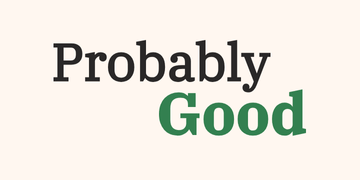As its name suggests, opportunity cost refers to the cost of choosing one opportunity over others. This “cost” reflects the value you could have gained in all the options you didn’t pursue. It’s a helpful concept to keep in mind with complex decisions as it can highlight the comparative value of all our options.
Guiding our choices
We often have to choose between different options when making decisions. Some of these choices are small, like what to eat for lunch or what movie to watch on the weekend. Other choices are much bigger, like what field to study, what career path to follow, or where to donate.
A common mistake is focusing solely on the benefits of a specific option without considering the value of other potential choices. Opportunity cost provides a framework to guide these decisions by emphasizing the value of what you might be giving up.
Real world example
Let’s say you have some money to donate and you’re deciding between two charities. When you eventually decide to give to charity #1, the charity you didn’t choose will lose the value that your money could have provided. Of course, this is an inevitable tradeoff of making any choice. You can’t donate everywhere, after all, and it’s a good thing to give any money at all, right?
Well let’s say this other charity #2 is much more effective than the one you chose. In fact, it’s so much more effective that your donation would save a dozen lives at charity #2 but only a few at charity #1.
In this case, your choice to donate to charity #1 comes at the cost of the impact your donation could have had at charity #2. Ultimately, this means that fewer lives are saved and the opportunity cost is quite high. Even though donating anywhere is better than donating nowhere, the difference between these two charities can lead to significantly different outcomes—making your choice less good than it initially seemed.
As this example illustrates, accounting for opportunity cost can help us understand the comparative value of our available options and spend our time, money, and effort more effectively. This is particularly important for avoiding spending limited resources on an option that seems attractive at first, because it has positive expected value, but will actually give you much worse value than another available option.
Assessing opportunity cost
To account for opportunity cost in practice, you can go through the following basic steps:
- Figure out which options are available to you.
- Determine the overall value of each option.
- Compare the value of the different options.
The key is to recognize that when you decide how valuable a certain course of action is, you shouldn’t look at its value in isolation, but rather compare it to the value of the alternative options you’ll be foregoing.
When to consider opportunity cost
Opportunity cost is relevant to many situations beyond charitable donations. For example, when deciding which cause to work on, understanding opportunity cost can help you identify where your unique skills might have the greatest impact.
Similarly, when choosing what to spend your time on at work, you might realize that although getting a certain certification could help you build career capital, the time you spent on this could cost you valuable networking time. If it turns out that networking is more valuable to your career than the certification, the cost of losing networking time may not be worth it.
Obstacles
Considering opportunity cost can be challenging, especially when facing uncertainty about which option will be more impactful. In such cases, gather more information by consulting relevant people or resources. Even if you can’t make a perfect decision, considering opportunity cost will help you make a more informed choice. When doing so, you can also benefit from considering other factors like counterfactual impact and neglectedness.
You can also explore

